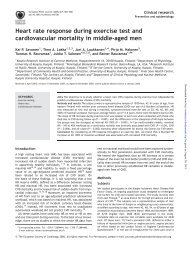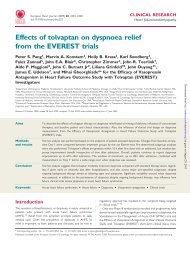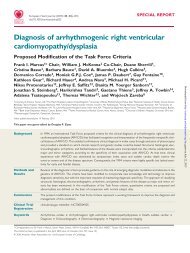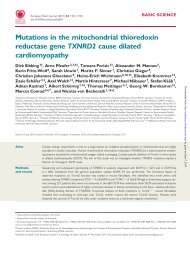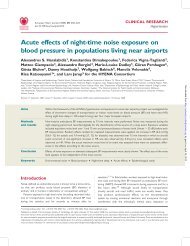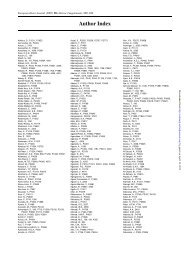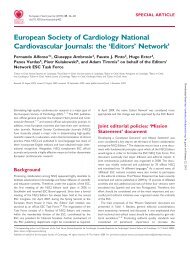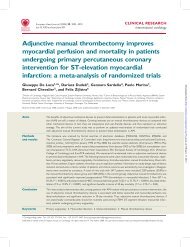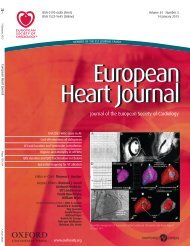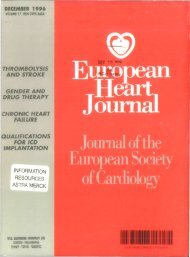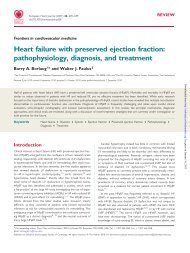Monday, 1 September 2008 - European Heart Journal
Monday, 1 September 2008 - European Heart Journal
Monday, 1 September 2008 - European Heart Journal
Create successful ePaper yourself
Turn your PDF publications into a flip-book with our unique Google optimized e-Paper software.
280 Stress echo in clinical practice / Non-invasive testing for arrhythmias<br />
chaemia. Therefore, we developed a three-dimensional (3D) analysis tool that<br />
makes it possible to anatomically align 3D rest and stress data systematically,<br />
to generate optimal, non-foreshortened standard anatomical cross sections and<br />
to analyse the images synchronised and side-by-side. The aim of the present<br />
study was to investigate whether this 3D analysis tool could improve interobserver<br />
agreement on myocardial ischaemia during 3D DSE.<br />
Methods: The study comprised 34 consecutive patients (22 men, mean age<br />
57±13 years) with stable chest pain who underwent both non-contrast and contrast<br />
3D DSE. Two observers scored segmental wall motion using a conventional<br />
analysis and the novel analysis with the new 3D tool.<br />
Results: At peak stress, 434 of the 578 segments (76%) could be analysed during<br />
noncontrast 3D imaging. With contrast-enhanced 3D imaging, the number of<br />
available left ventricular segments increased to 526 (91%). The two observers<br />
agreed on the presence of myocardial ischemia in 81 of 102 coronary territories<br />
(agreement 79%, kappa 0.28) during noncontrast 3D imaging and 92 of 102<br />
coronary territories (agreement 90%, kappa 0.65) during contrast-enhanced 3D<br />
imaging. With the new 3D analysis software these numbers improved to 98 of 102<br />
coronary territories (agreement 96%, kappa 0.69) during noncontrast 3D imaging<br />
and 98 of 102 coronary territories (agreement 96%, kappa 0.82) during contrastenhanced<br />
3D imaging.<br />
Conclusion: The use of a 3D DSE analysis tool improves interobserver agreement<br />
for myocardial ischaemia both for non-contrast and contrast images.<br />
NON-INVASIVE TESTING FOR ARRHYTHMIAS<br />
1851 T-wave variability detects abnormalities in ventricular<br />
repolarisation: a prospective study comparing healthy<br />
persons and olympic athletes<br />
L. Heinz1 ,A.Sax2 , F. Robert 2 , A. Urhausen2 , D. Luhm3 ,<br />
R. Ocklenburg3 ,J.O.Schwab4 . 1Bonn, Germany; 2Luxembourg, Luxembourg; 3Muenchen, Germany; 4University of Bonn, Department of<br />
Medicine-Cardiology, Bonn, Germany<br />
Introduction: Sudden cardiac death in athletes is more common than in the general<br />
population. Routine screening procedures are performed to identify competitors<br />
at risk. A new, Holter based parameter, analyses variation of the ventricular<br />
repolarization (TVAR). The aim of the present study was to evaluate differences in<br />
ECG, Echo, and Holter (H) in competitive athletes compared to a healthy control<br />
group consisting of medical students (MS).<br />
Methods: 40 athletes (19 female, Olympic Team, Luxembourg) and 40 MS (22<br />
female) were examined by means of a resting ECG, treadmill exercise (TE),<br />
echocardiogram (Echo), as well as H recordingsduring a routine screening visit.<br />
To analyze TVAR, a 20 min H recording at rest (sampling rate 2000 s -1 )was<br />
performed.<br />
Results: No differences in demographic variables were detected. The Table illustrate<br />
the findings of echo and H computations.<br />
Parameters of Echocardiography/Holter<br />
Parameter Athletes (mean±SD) Students (mean±SD) P-value<br />
<strong>Heart</strong> rate (bpm) 66±8 77±7



